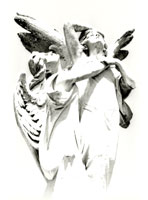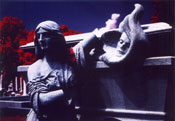 On walking through just about any cemetery established after 1850, one is likely to see sensual female figures, carved, or rather released, from a variety of material – granite, marble, bronze. This is principally true in France and England, the birthplaces of “garden cemeteries.” For the uninitiated, garden cemeteries are essentially outdoor sculpture gardens, conceived in Europe in the Victorian era (1837 – 1901) to try and dispel some of the fear and bleakness associated with death and dying. Pere Lachaise in Paris and Highgate in London are examples.
On walking through just about any cemetery established after 1850, one is likely to see sensual female figures, carved, or rather released, from a variety of material – granite, marble, bronze. This is principally true in France and England, the birthplaces of “garden cemeteries.” For the uninitiated, garden cemeteries are essentially outdoor sculpture gardens, conceived in Europe in the Victorian era (1837 – 1901) to try and dispel some of the fear and bleakness associated with death and dying. Pere Lachaise in Paris and Highgate in London are examples.
The practice carried across the Pond in 1831 with the founding of Mount Auburn Cemetery, in Cambridge, Ma. Photographic subjects here and from Laurel Hill (Philadelphia), and the Metairie Cemeteries (New Orleans) hearken back to the 1800s when such unique memorial gardens served the public as an idyllic getaway from the noisy city. Now forgotten by the public and worn by the elements, this rare artwork was enjoyed by our ancestors long before museums, galleries, and parks came into being.
Now, you’d think statues of semi-nude women would have clashed with Victorian sensibilities, wouldn’t you? Especially in a cemetery– a reverent public place frequented by the public! What role do these women play in the grieving process? They are symbolic, of course, but of what, affluence? These (typically life-sized) sensual figures do give memorial parks a feeling of life, which really was the original intent of the architects of the early garden cemeteries.
In his book, Death: The Trip of a Lifetime (1995), Greg Palmer offers that in many cultures, women are the designated grievers.” Ok, but why physically attractive females? As David Robinson says in his book Saving Graces, “Their gowns are revealing and they are often topless and sometimes nude.” He goes on to say that these statues were often individually commissioned and sculpted, often by famous sculptors. The image of the Warner Memorial at Laurel Hill Cemetery in Philadelphia, for instance, was sculpted by Alexander Calder’s great grandfather. In Western artistic tradition, the ability to accurately depict the female figure is what most defines artistic talent. So again, why physically attractive females? While her countenance may effectively express true sorrow and loss, there are no ugly angels. The anguish in the faces of the angels in “Lost at Sea” is no doubt meant to express the feeling felt by the man who lost his wife and daughter in a shipwreck off the coast of Louisiana in the mid 1800s off. This life-sized marble statue sits atop a mausoleum near the entrance to New Orleans’ grand Metairie Cemetery.
Besides the fact that most professional sculptors were male (we’ll assume at least some of them, like Rodin, were heterosexual) and these commissions afforded them a regular income, the sensuals provided an opportunity for them to bring their artistic fantasies to life for a noble purpose).
 If death is portrayed as beautiful, perhaps it will lose its sting. For Romeo and Juliet, as with the Romantic era in general (1825 – 1900), death was the focus of extreme emotion and the ultimate expression of love (Robinson, 1995). This period of time coincides with Victorian era, in which the idea of death in art and popular culture became less associated with horror and fright and more with love and desire. No other era in Western culture has ever exhibited to such an extent the artistic emphasis on death as a visible part of the consciousness of an entire population. In her book Mourning Art and Jewelry, Maureen DeLorme tells us that the pressures of continually facing death as an intrusion (French Revolution, Napoleanic Wars, high mortality from plagues and disease, etc.) made the need to keep both the presence of the departed near at hand while at the same time bidding farewell. So the idea of sculpted sensual beings in cemeteries became a tangible realization of a new Western psychology. Their purpose? To comfort the living and soften the finality of death. While angels may epitomize the tension between freedom and confinement, the sensuals walk the tightrope between spiritual purity and earthly desire. Undeniably conflicting, yet totally human forces of nature.
If death is portrayed as beautiful, perhaps it will lose its sting. For Romeo and Juliet, as with the Romantic era in general (1825 – 1900), death was the focus of extreme emotion and the ultimate expression of love (Robinson, 1995). This period of time coincides with Victorian era, in which the idea of death in art and popular culture became less associated with horror and fright and more with love and desire. No other era in Western culture has ever exhibited to such an extent the artistic emphasis on death as a visible part of the consciousness of an entire population. In her book Mourning Art and Jewelry, Maureen DeLorme tells us that the pressures of continually facing death as an intrusion (French Revolution, Napoleanic Wars, high mortality from plagues and disease, etc.) made the need to keep both the presence of the departed near at hand while at the same time bidding farewell. So the idea of sculpted sensual beings in cemeteries became a tangible realization of a new Western psychology. Their purpose? To comfort the living and soften the finality of death. While angels may epitomize the tension between freedom and confinement, the sensuals walk the tightrope between spiritual purity and earthly desire. Undeniably conflicting, yet totally human forces of nature.
The practice of memorializing the dead in such high fashion appears to have lost its appeal by the 1950s. A coincidence, perhaps, that this occurred in the era of artistic revolution plotted by Dylan Thomas (1952), in which he raged:
“Do not go gentle into that good night,
Old age should burn and rave at close of day;
Rage, rage against the dying of the light.”
All things not being equal, there have been many economic, religious, social, and psychological changes in Western societies. Medicine has greatly decreased mortality rates. Familial ties are not what they once were. And a technological advance has contributed to this–the advent of the camera. The photograph relieves us of the burden of memory, Susan Sontag says in her essay, “Uses of Photography,” (in “On Looking,” J. Berger, Pantheon Books, 1980). “With the loss of memory the continuities of meaning and judgment are also lost to us… the camera records in order to forget. “